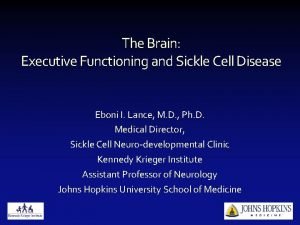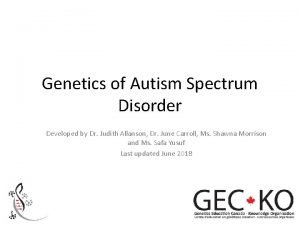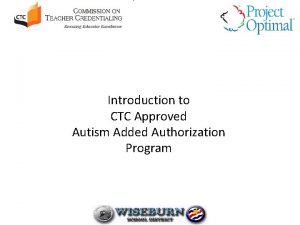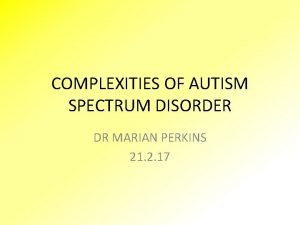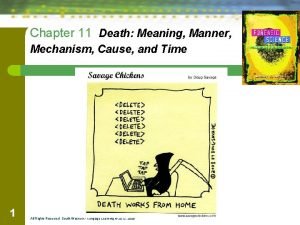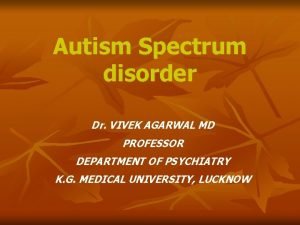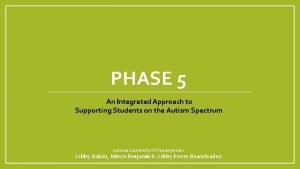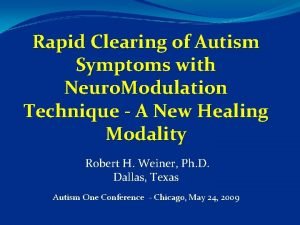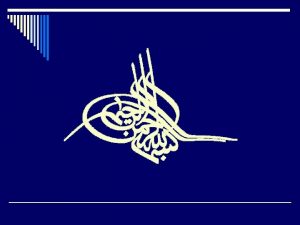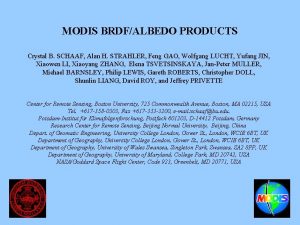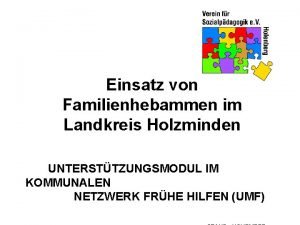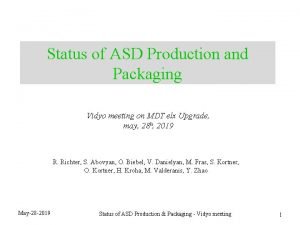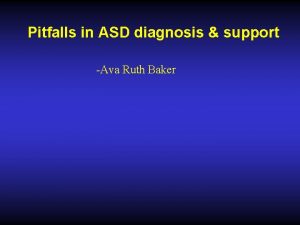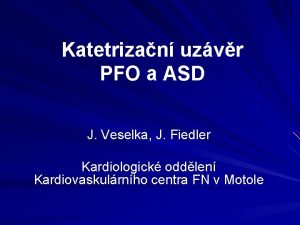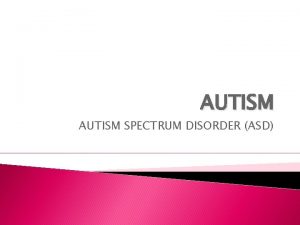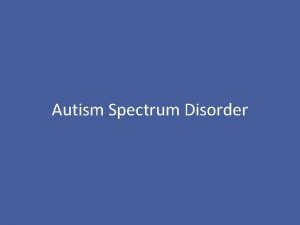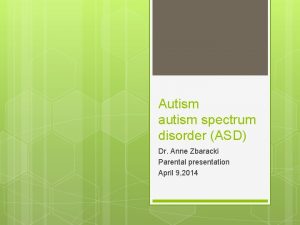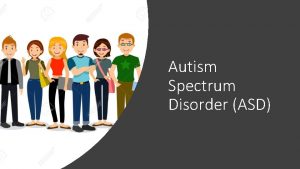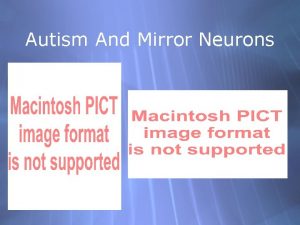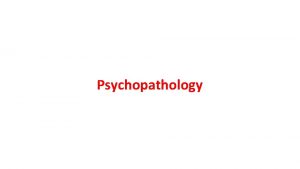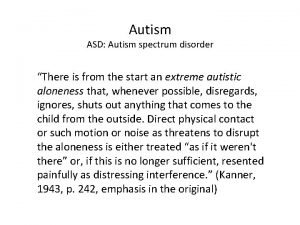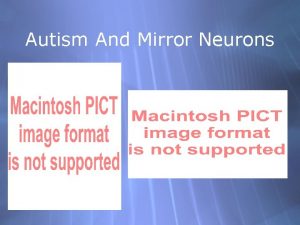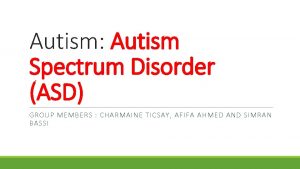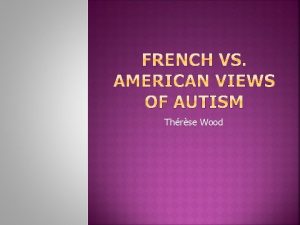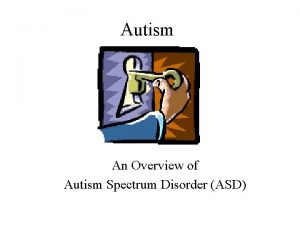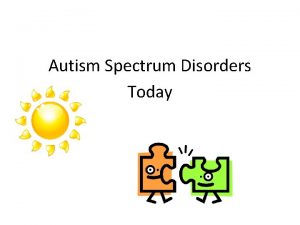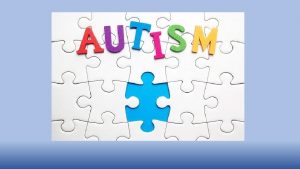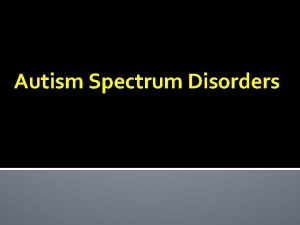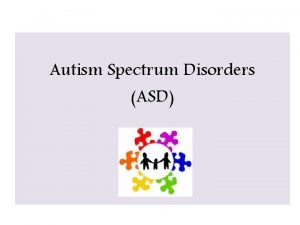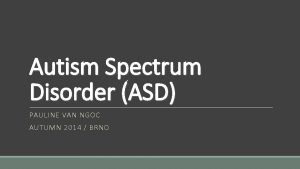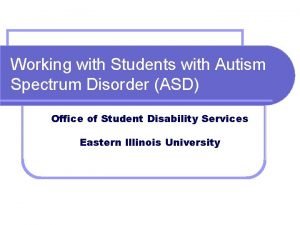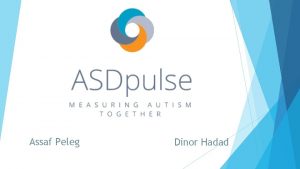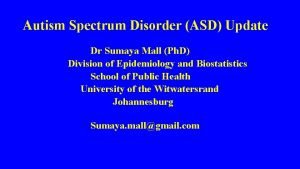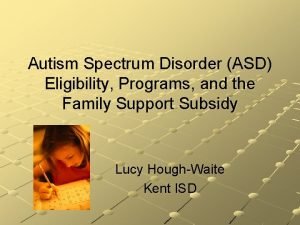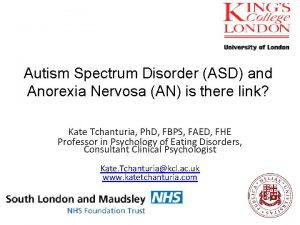ASD Autism Spectrum Disorder SSLD Intervention Ka Tat
























- Slides: 24

+ ASD (Autism Spectrum Disorder) SSLD Intervention Ka Tat Tsang 2017

+ Autistic Spectrum Disorder (ASD) n Autism (Kanner 1943) n Asperger’s Syndrome (Asperger 1944) n Impaired development of social skills n n n Social interaction: withdrawal, disengagement Processing of interpersonal information (e. g. , empathy, understanding other’s point of view, reciprocity) Interpersonal communication n Atypical behavior:repetition, self-injury, aggression n Dysfunctional relationship with objects:obsession with sameness, particular manipulation, over-reaction, unusual interest (e. g. , train schedule, make of automobile, calendar)

+ DSM-V 2013 A. Persistent deficits in social communication and social interaction across multiple contexts B. Restricted, repetitive patterns of behavior, interests, or activities, C. Symptoms must be present in the early developmental period. D. Symptoms cause clinically significant impairment in social, occupational, or other important areas of current functioning. E. These disturbances are not better explained by intellectual disability (intellectual developmental disorder) or global developmental delay. Intellectual disability and autism spectrum disorder frequently cooccur; to make comorbid diagnoses of autism spectrum disorder and intellectual disability, social communication should be below that expected for general developmental level.

+ Prevalence n From birth to 3 years n 45 to 90/10, 000 n 3 to 4 times more prevalent among boys than girls n Girls with autism have a higher probability of intellectual impairment n Family incidence rate 4 times that of the general population n Increase over the last 3 decades n n n Actual increase or improved detection and diagnosis? Over-inclusive/liberal diagnosis – political economy of diagnosis? Environmental pollution, diet?

+ Etiology: What are the causes? • • • Genetic: neurological development, Functional disorder Prenatal environment Nurture: environment, biochemical processes Psychogenic theory: generally discredited

+ Pathology: How Does It Affect the Child? • Structural and functional anomaly in the brain • Areas responsible for information processing and behavior more affected • Inability to synthesize and integrate information in different modalities • • Fragmentation, selective focusing on a particular dimension or specific elements of the overall information input Auto-stimulation • Social disorder: dysfunctional information processing including reception, integration, articulation, and expression • Impaired learning: Observation learning, imitation/modeling, symbolically mediated learning all affected

+ Treatment n No effective medical treatment available yet n Behavioral treatment is the major option in terms of n Symptom removal n Improving social competence n Subjective experience: autonomy, self-efficacy

+ Applied Behavior Analysis n Based on classical and operant conditioning principles n Systematic incremental training n Item by item progression (e. g. , getting dressed, making verbal requests) n Individual training of 30 to 40 hours per week Limitation/Problems n Very costly n High demand on the child’s emotion, energy, and involvement n Affects everyday life (family, socialization, schooling) n Difficulty in transfer of learning to real life situation

+ Early Intensive Behavioral Intervention (IBI) • Built upon ABA, founded by Lovaas (1987) at UCLA • Pivotal Response Training, Discrete Trial Training, shaping, backward chaining, etc. (Dillenburger & Keenan, 2009) • Home-based, required a minimum of two years of intensive intervention at forty hours per week • Parental involvement • Operant conditioning principles, ABC (antecedents, behavior, consequences) • Pivotal Response Training (PRT): Targeting social interaction, motivation, self-care, multimodal information processing

+ TEACCH Treatment and Education of Autistic and Related Communication Handicapped Children n Social environment to match the needs of the child n Helps the child to understand the external environment and to develop communicative ability (focusing on cognition and behavior) n Learning appropriate behavior to replace dysfunctional ones Limitation/Problems n Too structured (record schedules, learning aids, progress charting) n Transfer of learning to real-life

+ Filial Therapy Garza, Watts, & Kinsworthy, 2015 • A child and family centred modality whereby it is highly individuated per individual needs and strengths. • Conducted at home, didactic in nature, training of the family, focused on parents skills building • Highlights the importance of play-based, fun, experiential teaching. • Greater treatment effects than therapy led by clinicians; • Effective at improving family interpersonal relationships

+ Other Treatment Methods n Sensory Integration n Social Stories: Breaking social processes into simple, concrete units that are easier to grasp n PECS (Picture Exchange Communication Systems) n Floor Time: According to developmental stage, focuses on feelings and emotional development. DIR: developmental , individual difference and relationship based n Music therapy, art therapy n Animal/pet therapy n Filial therapy

+ Major Practice Challenges and Issues • Moving from classical (respondent) and operant conditioning paradigm to social learning • Engagement of multiple domains, not just behavior and intellectual/cognitive skills (motivation, emotion, interpersonal interaction, etc. ) • Increased involvement of parents or primary caregivers • Transfer of learning: Difference between treatment and in vivo (real life) environments more home-based

+ Key Pointers from Previous Research Reichow & Wolery, 2009; National Research Council, 2001 n Children should receive consistent and comprehensive treatment that fit their needs and developmental profile as soon as their needs are flagged. n Treatment must address the heterogeneous mix and interactions of symptomology, environmental factors and potential etiologies of the disorder. n The treatment must acknowledge the importance and benefit of low teacher to student ratios in intervention. n Progress speed may be impacted positively if intervention if occurs over at least 20 to 25 hours per week. n There must be ongoing assessment and evaluation of the child’s progress, developing needs and areas of strengths.

+ SSLD n An action oriented learning system that pays attention to all the key domains of the child’s functioning (biology, motivation, cognition, emotion, behavior) as well as the environment. n Aims at enhancing agentive, interpersonal, and social competence n Built on social cognitive theory, social and learning psychology n Systematic Learning n Personalized needs analysis and formulation of learning objectives n Learning how to learn through observation learning, modeling, and symbolic mediation n Feedback, review, refinement n Grounded in real-life performance

+ SSLD Understanding of Autism n The child is unable to process information effectively due to neurological impairment, especially complex and multi-modal interpersonal signals. (biology and cognition) n Inability to decipher and process information leads to feeling overwhelmed, perplexed, confused, and anxious (emotion) n Withdrawal or disengagement as strategies for avoiding negative emotional experience (motivation and behavior) n While other children can gratify various needs through social interaction, children with autism have to use other means such as auto-stimulation, control and manipulating objects, maintaining rigid order/pattern (motivation, behavior, environment)

SSLD Framework • • • Environment Body Motivation Cognition Emotion Behavior

Being-in-the-World Conventional Metaphysical Frame Social Biological SSLD Analytic Domains Environment Body Motivation Psychological Holistic Formulations Cognition Emotion Behavior Being/Selfhood/Identity Existential Spiritual Aesthetic Membership

SSLD Holistic Formulations SSLD Analytic Domains Environment • • Body Physical/Biological + Embodiment + Social construction Motivation Needs, Wants, Drive Cognition Information processing, making sense + beliefs, values + purpose + sense of self (not just memory and intellectual functioning) Emotional state + Emotional trait + Mood + Relational feelings Behavior Action + Articulation/Communication + Reflexes/Involuntary(e. g. , stereotypic) Being/Selfhood/I dentity Existential Spiritual Aesthetic Specific Components Membership Physical/Material Social/Symbolic (includes relationships)

+ What Happens in SSLD? n Through systematic learning, the child can master effective agentive, interpersonal and social strategies and skills. These will lead to need gratification, displacing the original symptoms. n In SSLD, the child does not only learn specific skills (e. g. , eye contact, verbal requests) but also learns how to learn – imitation, observation learning, and symbolically mediated learning n SSLD learning is grounded in real life, involving people in the child’s life world (parents, siblings, peers)

Problem Behaviour Replacing Problem Behavior ASD Strategies & Skills Stereotypic Repetitive Behavior Withdrawal, isolation Observation Learning Skills Needs/Goals Agency Affiliation Pleasurable Stimulation Control/Mastery Order Interpersonal Interaction Emotional Regulation Instrumental Skills

+ Special Features of SSLD n Learning how to learn: emphasis on observation learning (including symbolic mediation) as the most important mode of human learning n Focus on behavior, yet connecting it with the key domains of human experience and environmental realities n Individualized and systematic learning of adaptive skills and strategies n The child comes before the structure or system, which is used to facilitate the child’s learning. We modify the structure to suit the child, not the other way around.

+ Special Features of SSLD n Multiple contingencies thinking: Program design takes into consideration of the child’s circumstances and needs, developmental status, n Comprehensive attention to all domains: biology, motivation, emotion, cognition, behavior, and environment n Maximize opportunity, time, and space for learning - Mobilize family and people in the child’s life, Empowering parents through parallel learning program n Grounded in real life – minimize the difficulty of learning transfer n Pragmatism: Eclectic inclusion of other methods

+ If you want to learn more about SSLD You can visit our website at http: //ssld. kttsang. com/
 Autism spectrum disorder adhd
Autism spectrum disorder adhd Types of autism spectrum disorder dsm 5
Types of autism spectrum disorder dsm 5 Cdd disorder
Cdd disorder Autism spectrum disorder
Autism spectrum disorder Autism spectrum disorder authorization california
Autism spectrum disorder authorization california Social pragmatic communication disorder vs autism
Social pragmatic communication disorder vs autism Puberty and autism spectrum disorders
Puberty and autism spectrum disorders Factitious disorder vs somatic symptom disorder
Factitious disorder vs somatic symptom disorder Fetal alcohol spectrum disorder
Fetal alcohol spectrum disorder Spectrum disorder
Spectrum disorder Spectrum disorder
Spectrum disorder Absorption spectrum vs emission spectrum
Absorption spectrum vs emission spectrum Explain electronic configuration of cu and cr
Explain electronic configuration of cu and cr Wake tech admissions
Wake tech admissions Pddbi score interpretation
Pddbi score interpretation Dvd
Dvd Secondum
Secondum Asd crystel b
Asd crystel b Asd holzminden
Asd holzminden Vidyo status
Vidyo status Committee 3000
Committee 3000 Dr ava ruth baker
Dr ava ruth baker Big ass prof
Big ass prof Secundum asd
Secundum asd Uzvr
Uzvr
